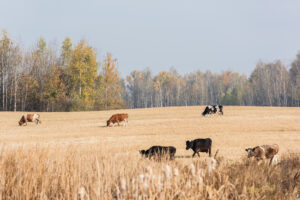A farming robot is not an innovation in agriculture. The mill, the enemy of Don Quixote, can be considered one of the first ways to automate farmers’ work using green energy.
However, the modern development of technology has stepped much further. Modern robots in agriculture are designed to solve labor and food shortages and save the maximum amount of water, fertile soil, and energy.
Robots in Farming – Market Overview
Agriculture is one of the industries that need automation more than others. The tremendous amount of work, dependence on manual labor, and the need to perform a vast number of routine actions to get a result have led to the fact that agriculture has become one of the most promising industries for integrating robotic solutions.
According to research results,
- Agricultural robotics will reach $75 million in revenues by 2024. For comparison, this figure is now $16.5 million in 2020.
- Agriculture will be the top target market for drones agriculture software developers, reaching $420 million by 2028.
- The global agricultural market will reach $20,6 million by 2024 (compared to $7.4 million to date).
Reasons to Use Farming Robots
Considering the scientific insights above, using robots in the agriculture industry is quite promising. Here are more reasons why robotics and agriculture are a perfect match.
Aging Workforce
The average age of a UK farmer is 58 years. And this is a global trend. Agriculture workers are mainly from the previous generation while growing crops and caring for animals requires significant physical effort. What is more, the younger generation prefers more prestigious jobs, which leads us to the next reason for using robots on farms.
Low-Cost Labor Shortage
The modern generation prefers intellectual labor to physical labor and does not want to work for pennies unless it is the first workplace or volunteer work. American agriculture can only offer $12 per hour on average, so the reluctance to work in this industry is justified.
Data-driven Insights
Meanwhile, modern farming robots equipped with computer vision, artificial intelligence, and GPS navigation are capable of collecting data on soil and crop conditions, monitoring seed germination and fruit ripening, and offering the best strategic solutions to farmers.
Earlier, harvesting was a matter of luck, and farmers prayed to whatever gods they knew for a fruitful harvest. Today, harvesting depends on the amount of knowledge on the condition of your crops.
Costs Cut
One of the main advantages of robots, regardless of the industry, is that the owners do not need to pay for labor. A one-time investment in developing or using a robot as a service (RaaS) and maintenance is the final cost.
Focus on Business Tasks
As long as the agricultural robot monitors the crop’s state and performs other routine tasks, the farmer can fully concentrate on optimizing their farm’s production and profitability. Instead, they can focus on business strategy, finding new distribution channels, and making the farm more environmentally friendly.
Agricultural Robots Applications
Here are the main robotic applications in agriculture. However, the list of possible applications is not limited to the ones we provide. A lot of promising solutions are still under development and testing. However, taking the pace of market growth into account, we can assume that we will see many more agriculture innovations very soon.
Scientific Approach to Crop Planting
An intuitive eye-to-eye approach becomes a relic of the past. Robotic solutions can calculate the ideal planting depth of the seed, as well as take into account the distance between the plants so that they do not interfere with each other’s growth, water, and sun supply.
Drone-Powered Harvest Monitoring and Analysis
Drones can collect data on the crop’s current state and deliver it to the farmer’s smartphone. Accurate analytical data allows farmers to take prompt action or simply ensure that crops are germinating as planned.
Fertilization and Irrigation
One of the main challenges for farmers is the rational use of water and fertilizers. AI-powered robots can suggest the optimal amount of water and herbicides to perfectly fit the plant’s needs and save as much water as possible using knowledge about a particular crop’s characteristics.
Effective Weed Control
Killing weeds is a hell of a job for the farmer, and over-spraying leads to low soil quality. Robots equipped with computer vision can separate a useful plant from a weed, pull it out along with the root and sprinkle as much chemical as is needed to eradicate the weed.
Careful Pruning of Plants
Robotic pruning technologies are already being used in the wine industry. Wall-Ye is a robot capable of carefully pruning grapes, while LettuceBot is also capable of carefully pruning lettuce leaves.
Harvesting
Harvesting robots are the next step in agricultural robotics development. This solution’s complexity lies in the fact that it is necessary to endow the robot with computer vision, teach it to distinguish ripe fruit from unripe, rotten from fresh, and train the robot to pick the fruit carefully not to crush it.
Agriculture Robots Types
Based on the robots in agriculture use-cases, it is possible to divide them into three types.
- Field robots. These are the robots that plant, water, weed, and harvest crops in fields and orchards.
- Drones. Drones are good at controlling, monitoring, and data collection. Being empowered by computer vision and face recognition features, they can also protect the field’s perimeter from harvest theft.
- Livestock robots. These are quite innovative robots that can be used for milking cows, for example. Also, livestock drones can be used to gather the herd and monitor their location and movement.
Conclusion
Agriculture is entirely dependent on manual labor and needs the constant attention of the farmer. It is an up-and-coming area for creating a robotics startup since automated, optimized, and ecological agriculture has the best chances to solve one of the world’s biggest threats: hunger.
